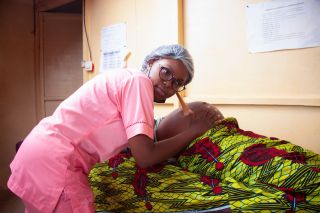Psychopharmacology
The Use of Antipsychotics During Pregnancy
What impact, if any, might antipsychotics have on a developing fetus?
Updated November 28, 2023 Reviewed by Abigail Fagan
Key points
- Antipsychotics warrant concern for expecting mothers.
- Psychosis may increase the risk for expecting mothers due to the nature of the illness aside from medications.
- Second generation antipsychotics show little increased risk for birth defects.

There tends to be a lot of concern about antipsychotics and their potential effects on a newborn. If women who wish to have children and live with schizophrenia, how can these women maintain their psychiatric care while pregnant and planning for a family?
Previous literature on this topic have provided little evidence to support the claim that there is an association between congenital malformations and tertogenic effects. The confounding factors of living with a difficult illness as well as the current drug treatments used to provide relief for that illness makes it difficult to understand which side of the condition is the most harmful.
Women with schizophrenia are at risk for adverse pregnancies in general due to the unstable nature of the disorder. Without proper care, newborns and children may be at risk for other complications such as infant-mother attachment and quality childcare. Some studies show that discontinuation of antipsychotics is more prevalent in women living with the disorder while pregnant.
Little Increased Risk for Congenital Malformations
A study published in 2021 in the Journal of Clinical Psychiatry investigated reproductive safety in the use of second generation antipsychotics (SGA) during pregnancy. The data come from the Massachussetts General Hospital national pregnancy registry.
The researchers were able to access the pediatric and medical records of the 621 women (age 18 to 45) and their children involved in the study who were exposed to SGAs during the first trimester of pregnancy. The records were reviewed to screen for evidence of malformations. The rate of prevalence of malformations in the exposed group was 2.5 percent compared to 1.99 percent for the women and children who were not exposed to SGAs during pregnancy.
It is important to note that the Center for Disease and Control also reports a 2.5 percent rate of malformations in the general population as well. The researchers suspected that the lower rate of the 1.99 percent for non-SGA-exposed participants may have been due to random error or healthier rates of women who chose to enroll in the study.
Two other studies reported a 1.5- to 2-fold increase in malformations particularly in cardiac defects in SGA-exposed newborns, but the researchers of the Massachussetts General Hospital study warn of detection bias, because women on SGAs are more likely to be monitored using fetal echocardiography compared to the general population.
A defining trait of a teratogen is a consistent pattern of malformation. If congenital malformations are due to antipsychotics as a whole, and it were true that antipsychotics caused congenital malformations, then there would be a higher likelihood of a consistent malformation exhibited in the records of these participants. This study did not find any single major malformation consistent across records.
The study generally found that there was no increased risk of using SGAs on infants in the mother’s first trimester of pregnancy.
Other Findings
These findings mirror other studies as well, including a study conducted in Denmark who did not report a significant increased risk of congenital malformations during the first trimester of pregnancy.
However, there are some studies that reveal opposing results, such as a study conducted in Finland that reported an increased risk of congenital malformations like gestational diabetes. However, this study and the above study used different statistical analyses, with the American study reported above, to examine for confounding factors such as drug use, detection bias, and more.
The overall trend of using SGAs during the first trimester of pregnancy seems to reveal little increased risk of congenital malformations during use, and if there are, the rate is no higher than the general population as reported by the CDC. Additionally, there is no consistent rate of any one type of malformation, which is a hallmark feature of a congenital teratogenic.
References
Ellfolk, M., Leinonen, M. K., Gissler, M., Lahesmaa-Korpinen, A. M., Saastamoinen, L., Nurminen, M. L., & Malm, H. (2020). Second-generation antipsychotics and pregnancy complications. European Journal of Clinical Pharmacology, 76, 107-115.
Liu, X., Kolding, L., Momen, N., Gasse, C., & Pedersen, L. H. (2023). Maternal antipsychotic use during pregnancy and congenital malformations. American journal of obstetrics & gynecology MFM, 5(6), 100950.
Viguera, A. C., Freeman, M. P., Góez-Mogollón, L., Sosinsky, A. Z., McElheny, S. A., Church, T. R., ... & Cohen, L. S. (2021). Reproductive safety of second-generation antipsychotics: updated data from the Massachusetts General Hospital National Pregnancy Registry for Atypical Antipsychotics. The Journal of Clinical Psychiatry, 82(4), 35609.




